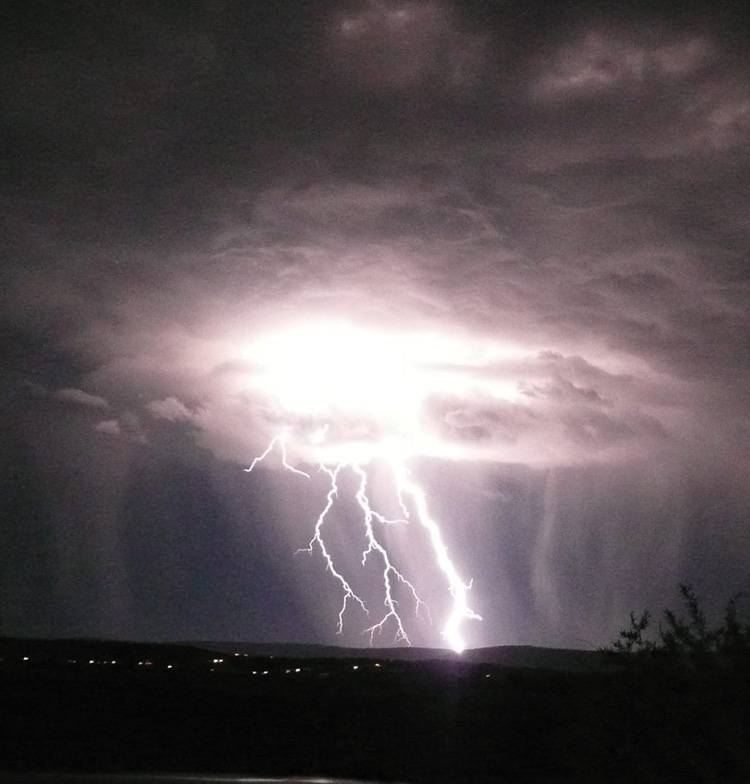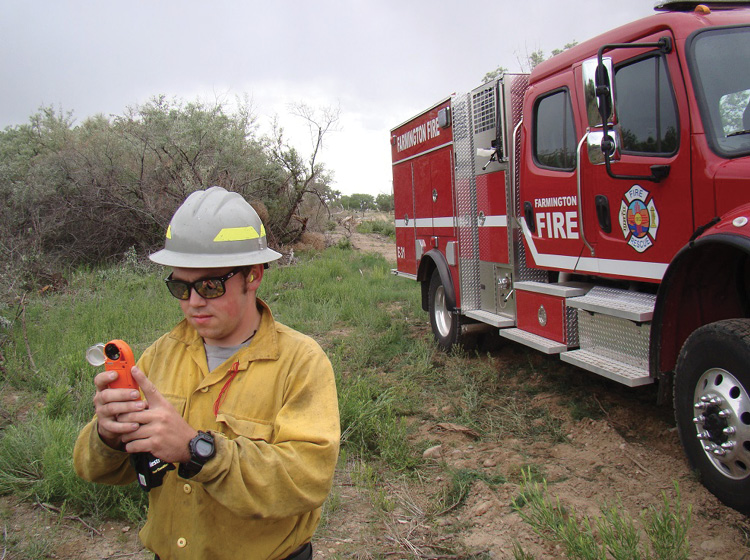
Wildland Urban Interface ❘ By THOMAS W. AURNHAMMER
The three factors that have the most impact on wildland fire behavior are topography, fuel, and weather. Weather is the most active of these influences, and structural firefighters operating at a wildland urban interface (WUI) fire must understand the effect that meteorological conditions have on trying to control a WUI incident.
Critical Factors
Just as in structural firefighting, WUI fires have critical factors that can seriously impact the outcome of the incident. Blue Card aficionados should be familiar with the concept of fixed and variable factors. Fixed factors are things that the incident commander (IC) cannot change; topography, fuel, and weather certainly fall into this critical factor category. Fixed factors at a wildland fire can raise specific hazards that the IC must factor into the incident action plan. Weather should be considered a fixed factor because of our inability to change it. The more firefighters understand the dynamics of fire incident weather, the better prepared they become when facing a WUI fire.
Situational Awareness
Daily fire weather forecasts and other information are available at the National Weather Service’s Fire Weather1 web page (www.weather.gov/fire). I highly encourage company officers to access the daily fire weather forecast and review it during the morning briefing or through other methods your organization has for sharing information with the troops. The forecast provides information on expected weather as well as other important pieces of information including warnings, watches, and behavior; the Haines Index; and lightning activity levels.

(1) Structural firefighters within wildland urban interface response areas should incorporate discussions of fire weather forecasts into their crew briefings. (Photos by author.)

(2) An “Extreme Fire Behavior” alert provides a “heads-up” for potentially erratic fire conditions.
Fire Weather Basics
Wildfire warnings, watches, and behavior. A “Red Flag” warning is issued to alert firefighters of an ongoing or imminent critical fire weather pattern. It is also issued to alert firefighters of ongoing or expected critical fire weather conditions. A “Fire Weather Watch” is declared to caution firefighters that upcoming weather conditions could result in extensive wildland fire incidents or extreme fire behavior. This watch also means critical fire weather conditions are possible but not imminent or occurring.
An “Extreme Fire Behavior” alert denotes that a wildfire is expected to rage out of control and behave erratically. This heads-up is released because one or more of the following conditions have been noted: fast-moving fires with a high rate of spread, fires crowning or spotting, the presence of fire whirls, or a strong convection column.
The Haines Index. The Haines Index indicates the potential for rapid fire growth because of dry and unstable atmospheric conditions over a fire area. This index is a simple way to measure the atmosphere’s contribution to the fire’s growth potential. The index is expressed numerically, with a minimum of “2,” indicating a very low spread potential, to a maximum of “6,” indicating a high spread potential.
Lightning Activity Level (LAL) (Table 1). This scale describes the degrees and types of lightning activity.
Table 1. Lightning Activity Level Scale |
|
|
1 |
No Thunderstorms |
|
2 |
Isolated Thunderstorms |
|
3 |
Widely Scattered Thunderstorms |
|
4 |
Scattered Thunderstorms |
|
5 |
Numerous Thunderstorms |
|
6 |
Widely Scattered Dry Thunderstorms |
Thunderstorm and Lightning Safety
Firefighters are urged to take thunderstorm precautions as soon as they hear thunder and should not wait until the storm has arrived. A good rule of thumb is to take shelter in a vehicle or building and suspend work for 30 minutes until after the storm has passed. Structural firefighters operating in the WUI must become familiar with lightning hazards, the methods for avoiding those hazards, and what actions to take if a crew member is struck.
Spot Weather Forecasts
You can request spot weather forecasts for fires that have the potential for active fire behavior, have exceeded initial attack capabilities, or are in areas where a Red Flag warning has been issued. The National Weather Service’s Spot Forecast Request and Dissemination System provides a method for requesting fire weather spot forecasts, and it allows forecasters to disseminate those forecasts to a national Web server.

(3) Thunderstorms and lightning can create hazards ranging from additional fire starts to firefighters being struck.
Once again, preplanning will make this operation much smoother. Having a relationship with the local wildland fire interagency dispatch center can be invaluable. Most of these dispatch centers provide wildland fire, air resource, logistical, and intelligence support to cooperating agencies. In the midst of a WUI incident, it may be easier to contact the dispatch center to process the spot weather request. You must provide the following information to dispatch no matter what method is used for the request:
- Location of the incident (address, latitude/longitude, or U.S. national grid).
- Type of incident.
- Incident name.
- Requesting agency.
- Elevation.
- Fuel type.
- Forecast delivery time (as soon as possible or later).
- Any additional information that could help meteorologists with the forecast.
Fire Weather Kits
A kit containing instruments for reading wind speed, temperature, and relative humidity is a great tool for gathering fire weather information. The kits are available in two types: a “belt” weather kit, which contains an anemometer for measuring wind speed, and a sling psychrometer to measure temperature and relative humidity. An electronic all-in-one digital instrument can also provide accurate meteorological data. These electronic weather kits collect data with an easy-to-use device.
Which is the best? That discussion ranks right up there with the straight stream vs. fog nozzle debate. No matter what type of kit you use, you must train on the instruments before you use them at a fire. The United States Department of Agriculture (USDA) Forest Service National Technology and Development Program’s report Fire Management Tech Tips takes an in-depth look at the features, advantages, and disadvantages of each kit. The report is available at www.fs.fed.us/t-d/pubs/pdf/hi_res/11511303hi.pdf.

(4) You can check wind speed, temperature, and relative humidity on scene with an all-in-one digital instrument.
There’s an App for That!
Several mobile phone applications are available for wildland firefighting in general and for fire weather specifically. The Alaska Wildland Fire Information Web site provides a list of applications that are widely used in the wildland fire community. The list can be found at https://akfireinfo.com/2016/07/28/where-you-go-to-help-you-know-wildland-fire-mobile-apps-cheat-sheet. Additional information on fire weather apps can be accessed through the Southern Fire Exchange at www.southernfireexchange.org/Models_Tools/Weather_Apps.html.
Additional Reading
Although the Internet contains a plethora of information on the impact of weather on wildland fires, one document stands out as a “must-read” for structural firefighters looking to gain more knowledge in the science behind fire weather: The Fire Weather Agriculture Handbook 360, published by the USDA Forest Service in 1970, contains information that cuts through technical terms in relating basic weather knowledge to wildland fire. Although it has been almost 50 years since this book was first published, the basic principles and the effects of weather on wildland fires are still valid. Download the handbook at https://training.nwcg.gov/pre-courses/s290/Fire_Weather_Handbook_pms_425.pdf.
The influence of weather on wildland fire behavior creates the need for structural firefighters operating in the WUI to have a greater awareness of potential weather-related hazards. Understanding how the local fire weather forecast impacts firefighter safety can assist in making better strategic and tactical decisions at the scene.
In 1994, 14 wildland firefighters died in the line-of-duty at the South Canyon Fire, outside of Glenwood Springs, Colorado. Fire crews were overrun by a sudden and unexpected blowup in one area of the fire. Weather forecasts were not requested or supplied, and the investigation report on the incident concluded that weather “contributed significantly” to the fire’s intensity and spread and the firefighter fatalities. Prepare accordingly and know all the options available to you in your WUI fire preplan so your department does not become another statistic.
THOMAS W. AURNHAMMER is a 43-year fire service veteran, a fifth-generation firefighter, and the chief (ret.) of the Los Pinos Fire District in Ignacio, Colorado. He is a graduate of the National Fire Academy’s Executive Fire Officer Program and has a bachelor of science degree in fire administration. Aurnhammer also has the Chief Fire Office designation and is a member of the Institution of Fire Engineers, U.S. Branch.
Structural Triage in the Wildland Urban Interface

